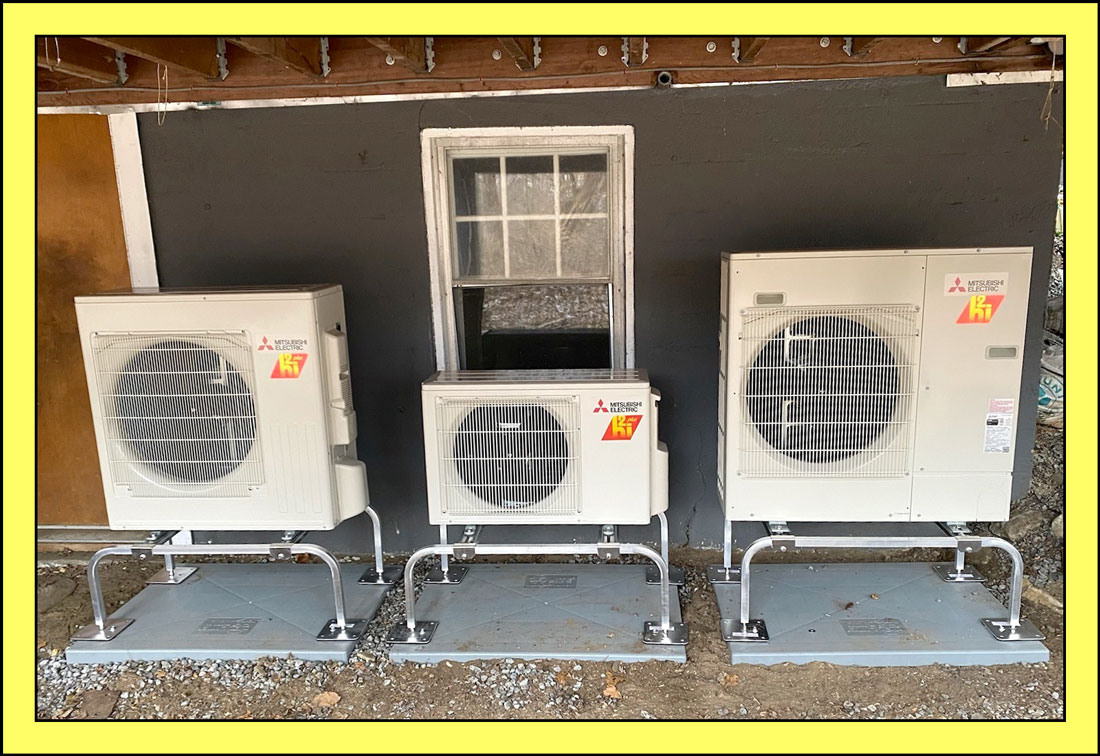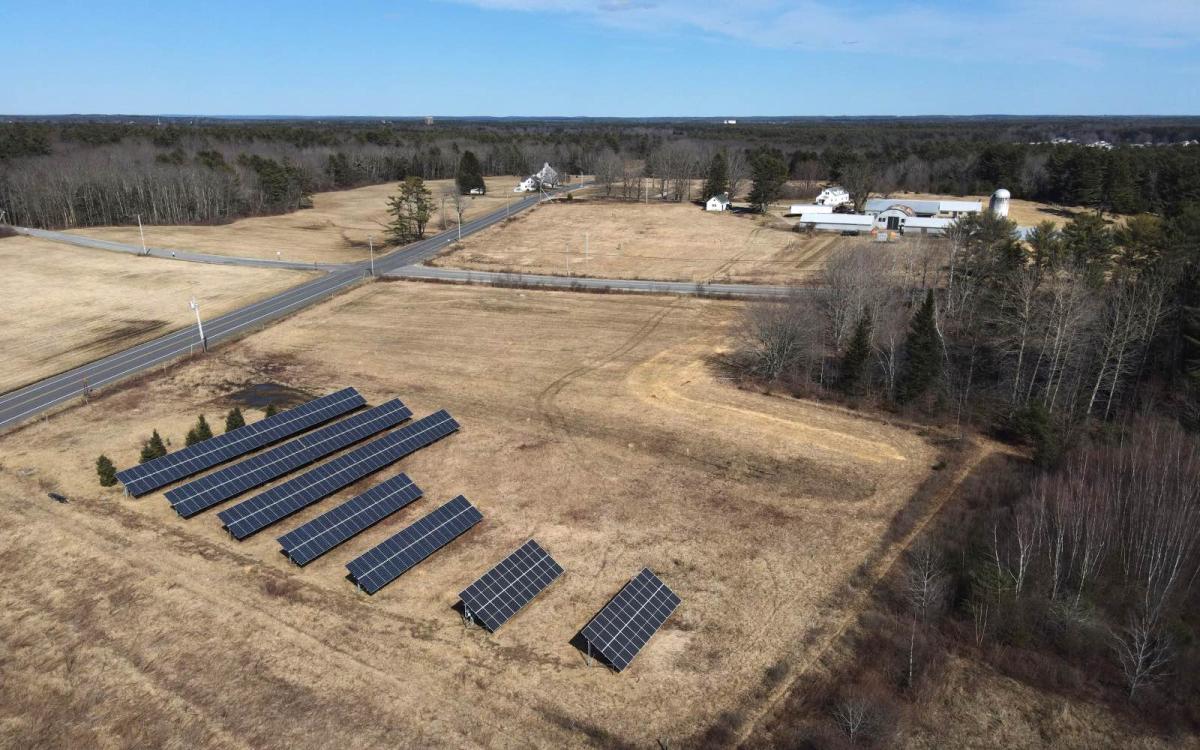Grist writer Tik Root documented his experiences updating his home with cleaner, more climate-friendly systems.

When Grist writer Tik Root set out on a journey to decarbonize his home, he didn’t intend at first to document the effort. As a journalist covering climate, he’s had years of experience reporting on electrification, energy, and technology — and demystifying those often complex topics for the average consumer. But the decision to write about his own experiences as a homeowner attempting to ditch fossil fuels came about two-thirds of the way through what amounted to more than a yearlong process.
“I said, ‘OK, if I spend all my days on this and I’m learning so much, maybe other people will learn something, too,’” he recalled.
Residential energy use accounts for roughly one-sixth of total greenhouse gas emissions in the U.S. Our homes remain heavily reliant on fossil fuels, and natural gas in particular. But that’s beginning to change — electric heat pump sales are outpacing gas boilers, and some cities have passed resolutions banning the use of natural gas in new construction. Legislation like the Inflation Reduction Act has also sought to make it cheaper and more accessible for Americans to upgrade their home energy systems and appliances to more efficient ones.
Still, that doesn’t mean that renovating a home to be more climate-friendly is easy, or cheap, as Tik and his wife discovered. Even a pair of climate journalists encountered obstacles and tough decisions over the course of a process that took several times longer than they initially expected.
“Build in time,” Tik recommends to anyone pondering similar upgrades. “It’s gonna take longer than you think.”
He chronicled his and his wife’s experiences in a first-person feature for Grist, which published today — and he shared a few of his top takeaways for Looking Forward. In addition to budgeting more time than you think you’ll need, Tik recommended leaning on family and friends who have been early adopters of things like heat pumps, induction stoves, and solar panels.
“It’s only a matter of time — if not already — before someone on your block has a heat pump, and if you ask them about their process, you could probably skip a whole lot of steps,” he said. Shortly after he and his wife installed heat pumps on their two-story home in Burlington, Vermont, a neighbor who had noticed the contractor’s truck in their driveway called to ask about it and see if she could hire the same installer. “I think my neighbor probably saved three months of work,” Tik said. “And my friend is just about to do the same; my dad will do the same.”
A home’s heating system is the big-ticket item, in terms of financial investment and emissions-saving potential. For Tik and his wife, the journey leading up to installation involved a comparison of different models of heat pumps, a lengthy detour exploring rooftop solar (to offset some of the energy demands, and cost, of their new all-electric systems), and a brief moment of panic when they feared they’d have to upgrade their electrical panel. They worked through each of these decisions one by one, culminating in a successful — even joyful — installation in early January.

The heat pump setup that Tik and his wife chose is a “mini split” system. It consists of three condensers (one for each floor), installed outdoors, and ductwork in the attic to reach the upstairs bedrooms. Phillip Martin
We’ve pulled an excerpt from Tik’s feature below (lightly edited for clarity), highlighting some of the other, lower-lift projects that he and his wife tackled to begin weaning the full house off of natural gas. Check out the full feature, with all its twists and turns, here.
— Claire Elise Thompson
![]()
Our first foray into discarding gas was installing a heat pump water heater. It works a bit like an air conditioner in reverse by drawing warmth from the surrounding air to bring water up to temperature, and the technology is growing in popularity. Not only are heat pumps energy-efficient, they can also do a bit of dehumidification, which our musty basement sorely needed. The process went deceptively smoothly.
We gathered several quotes — something the [director of research for the electrification nonprofit Rewiring America] and others told me is critical to managing costs. The lowest was $2,825 to install a 50-gallon tank, a price that was on the high end of Energy Star guidance but hundreds less than the others. A $600 instant rebate from the state and an $800 post-purchase one from the city brought the cost to $1,425. I happened to have a friend who needed one too, so we both got another $150 off for doing them together. The IRA provides a tax credit of 30 percent of the total cost (up to $2,000), though we won’t get it until after we file our taxes.
All told, the bill will come to $428, plus a couple hundred more to have an electrician wire it. Installation took less than a day and the water heater is now humming happily in our basement. Although the emissions savings will be negligible because we still need our boiler for space heating, it was a confident first stride toward reducing our dependence on gas.
Buoyed by the success, we took aim at the stove and the dryer.
![]()
Electrifying appliances isn’t yet a major climate win. The average dryer uses around 2,000 cubic feet of natural gas a year, with CO2 emissions roughly equivalent to driving about 300 miles. Gas stoves consume about the same amount. At best, going electric fully displaces those greenhouse gases. But the advantages are even smaller beyond Vermont, where local utilities aren’t as clean. The nation still generates 60 percent of its electricity with fossil fuels (43 percent of that from natural gas) and until that changes, junking a gas stove is roughly a wash for the planet.
Our main motivation for jettisoning gas appliances was the blinking light on our air purifier. We’d read the research showing that cooking over gas produces benzene and nitrogen dioxide. But seeing that little diode change from a soft blue to a harsh red every time we cooked was a menacing reminder of the risks. It grew even more unsettling when we found out we’d become parents, as gas stoves have been linked to nearly 13 percent of the nation’s childhood asthma cases.
The consensus among climate experts and, perhaps equally importantly, chefs is that the best alternative is an induction stove, which uses electromagnetic energy to heat cookware. It requires less energy than a traditional electric range and offers greater temperature control. But as we started exploring options, we quickly realized the technology doesn’t come cheap. The least expensive models start at around $1,100, or almost twice the price of a basic gas stove. Advocates of the tech say prices should come down as it becomes more widespread, but that didn’t do us much good, and our city’s rebate was just $200. We hoped Black Friday would further blunt the financial blow, though that meant waiting a few months. We used the time to weigh whether we wanted features such as a convection oven (we did) and, come November, headed to Lowe’s.
Given my proclivity for buying power tools I don’t need, my wife hustled me directly to the appliances. Alas, the store had just one induction model on display, and it wasn’t the one we wanted. But the conventional stoves were similar enough that we could get a sense of how the induction version might feel in the kitchen. After much pressing, twisting, hemming, and hawing, we chose a Samsung induction model with knobs rather than buttons, which we knew from a relative’s experience could be finicky. The list price was $2,249, but we got it for nearly half off with the holiday sale.
On the way out, we solved our dryer dilemma when we happened upon a well-reviewed electric model similarly marked down to just $648. We pulled out our phones and compared it to a heat pump dryer, which would have used less electricity and spared us the trouble of installing another outlet and a vent. But aside from being considerably more expensive (even with an extra state rebate), the heat pump version had just half the capacity. Given the mountains of laundry newborns produce, we chose the traditional tech, with the hope that larger models are available next time we need a dryer.

Leaving the store, I nearly blew our savings on a track saw. Good job I showed restraint, as installing outlets to power our purchases was much more expensive than expected. The electrician charged more than $600 for the stove hookup, and the dryer outlet, when our basement revamp is ready to accommodate it, will likely run about the same. Although that’s about two-thirds the cost of appliances, we saw the benefits of ditching gas almost immediately.
My wife does most of the cooking and swoons when she switches on an induction burner. Water boils far faster than with the gas stove and even more quickly than in our electric kettle. “It feels almost instant,” she said. “The bubbles are crazy.” The heat is also precise enough to keep pasta sauce at a simmer and food perfectly warm while we gather our dinner plates.
Best of all, it’s been months since we’ve seen the red light on our air purifier.
— Tik Root
![]()
CORRECTION: In last week’s newsletter, about alternatives to synthetic fabrics, we failed to note that textile recycling company Renewcell filed for bankruptcy last month. Next steps for the company, its patented technology, and its stores of recycled material are uncertain.
Although Tik and his wife ultimately decided against putting solar panels on their roof, they are now looking into community solar — an arrangement that lets neighbors buy into a larger solar installment in a centralized location, like a school or a church. Here’s one such project on Crystal Spring Farm in Brunswick, Maine. The panels are cooperatively owned, and they provide energy to the farm as well as several nearby families that wouldn’t otherwise have access to solar power individually.

This story was originally published by Grist with the headline A journey into home electrification on Mar 21, 2024.